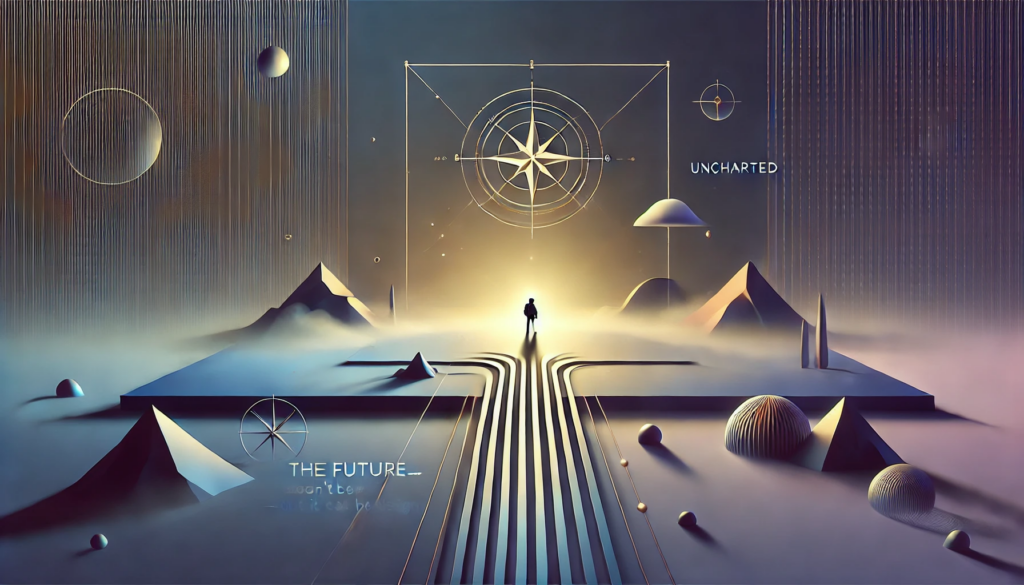
ChatGPT:
Uncharted: How to Map the Future Together – Margaret Heffernan
Margaret Heffernan’s Uncharted is a thought-provoking book that challenges our assumptions about predictability, forecasting, and control over the future. She argues that despite advances in data science, artificial intelligence, and statistical modeling, the future remains inherently unpredictable. Instead of relying on flawed forecasts, she advocates for adaptability, creativity, and collective problem-solving as essential tools for navigating an uncertain world.
Through a blend of historical case studies, scientific insights, and practical examples, Heffernan illustrates how societies, businesses, and individuals have successfully dealt with unpredictability. She emphasizes that embracing uncertainty rather than fearing it allows for innovation and resilience.
Introduction: The False Promise of Prediction
Many people believe that with enough data and analysis, the future can be mapped out with precision. Corporations, governments, and individuals invest billions in predictive models to prepare for market shifts, elections, and technological advancements. However, Heffernan argues that these efforts are often misguided because the world is too complex and dynamic to be accurately predicted.
She highlights past failures of prediction, such as the 2008 financial crisis, Brexit, and the election of Donald Trump—events that defied expert forecasts. The lesson is clear: rather than relying on flawed predictions, we should cultivate the ability to respond to change with agility and innovation.
The Limits of Big Data and AI
Technology has fueled the belief that artificial intelligence and big data can provide near-perfect forecasts. Companies like Google and Amazon use data analytics to predict consumer behavior, while financial markets employ AI to model economic trends. However, Heffernan warns against over-reliance on these tools for several reasons:
1. Data Bias – AI models are only as good as the data they are trained on. If the input data contains biases, the predictions will be flawed.
2. Unpredictable Human Behavior – People do not always act rationally, making it impossible for algorithms to account for sudden changes.
3. Complex Systems – The world is interconnected in ways that are impossible to fully map out. A small event in one part of the world can trigger major disruptions elsewhere.
She argues that while AI can be a useful tool, it cannot replace human intuition, judgment, and the ability to think creatively in the face of uncertainty.
Case Studies: Success Without Prediction
Heffernan presents numerous examples of how individuals, organizations, and societies have navigated uncertainty successfully without relying on predictions:
- Medical Breakthroughs and Serendipity
Many major medical advancements were not the result of precise planning but rather of curiosity and open-ended research. The discovery of penicillin, for instance, happened by accident when Alexander Fleming noticed that mold in his petri dish killed bacteria. If he had been rigidly following a set research plan, he might have discarded the unexpected results instead of investigating them further.
- Political and Social Movements
Movements like the civil rights movement, the fall of the Berlin Wall, and the Arab Spring were largely spontaneous. They were not predicted by political analysts, nor were they controlled by a single leader. Instead, they emerged organically as people responded to real-world conditions.
- Businesses Thriving in Uncertainty
Some of the most successful companies, such as Pixar and Spotify, have embraced uncertainty by fostering creativity and adaptability. Pixar, for example, encourages its teams to experiment with new storytelling techniques rather than relying on rigid formulas for success.
How to Prepare for an Uncertain Future
Heffernan offers several strategies to help individuals, businesses, and societies better navigate an unpredictable world:
- Cultivate Creativity and Experimentation
Rigid planning often fails in complex environments. Instead, she advocates for an experimental mindset, where trial-and-error leads to innovative solutions. Prototyping, improvisation, and learning from failure are crucial strategies.
- Encourage Collaboration and Diversity
The best solutions often come from diverse teams that bring different perspectives and experiences. Organizations that encourage open dialogue and knowledge-sharing are more resilient.
- Build Adaptive Institutions
Governments and businesses should shift from bureaucratic, top-down structures to more flexible and responsive models. This includes fostering local decision-making, allowing for rapid adjustments in response to emerging challenges.
- Accept Uncertainty as a Feature, Not a Bug
Uncertainty should not be seen as a threat but as an opportunity for innovation. By embracing the unknown, individuals and organizations can remain agile and open to new possibilities.
- Invest in Human Skills Over Algorithms
Empathy, ethics, and intuition are uniquely human traits that AI cannot replicate. Investing in education that prioritizes these skills will be more valuable than relying solely on data-driven decision-making.
Conclusion: A More Humane Future
Margaret Heffernan’s core message is that trying to control or predict the future is a futile endeavor. Instead of wasting resources on forecasting, we should invest in developing the skills that help us respond effectively to change: creativity, collaboration, adaptability, and resilience.
By shifting our mindset from control to curiosity, we can navigate uncertainty with confidence and build a more innovative, humane, and resilient future.
Key Takeaways
🔍 Prediction is unreliable – The world is too complex and dynamic for accurate forecasting. Relying on predictions can create false confidence and lead to poor decision-making.
🧠 Creativity is a survival tool – The ability to think creatively and adapt is more valuable than trying to anticipate every possible outcome.
👥 Diverse teams are stronger – Collaboration across different backgrounds and perspectives leads to better solutions in unpredictable situations.
📉 Data has limitations – While AI and big data are useful, they cannot fully capture the complexity of human behavior and societal change.
🎭 The arts as a model for uncertainty – Artists, musicians, and writers embrace ambiguity and unpredictability, offering valuable lessons on how to navigate the unknown.
🏗️ Adaptive institutions are the future – Governments and businesses need to become more flexible and responsive rather than relying on rigid policies.
🔄 Resilience is key – Individuals and organizations that can quickly adjust their strategies in response to change will thrive.
💡 Serendipity drives innovation – Many of history’s greatest breakthroughs were the result of unexpected discoveries, not carefully laid-out plans.
🌎 A humane approach to uncertainty – Instead of fearing the unknown, we should build societies that encourage open-ended exploration and learning.
Summary
1. The future is unpredictable – No amount of data or forecasting can accurately predict the future due to the complexity of human and societal behavior.
2. Why predictions fail – From economic crises to political upheavals, history shows that even the best experts get it wrong.
3. Embracing uncertainty – Instead of resisting uncertainty, we should develop skills that allow us to respond effectively to change.
4. Medical and scientific breakthroughs – Many major discoveries happened by accident or open-ended experimentation rather than precise planning.
5. The power of collaboration – Collective problem-solving is more effective than isolated decision-making in uncertain environments.
6. The limits of AI and big data – Algorithms cannot fully account for human unpredictability, and over-reliance on them can lead to flawed decisions.
7. The role of creativity – The most successful organizations foster innovation by encouraging creative risk-taking.
8. Lessons from history – Movements like the fall of the Berlin Wall and the civil rights movement emerged unexpectedly, showing the power of organic change.
9. Rethinking institutions – Governments and businesses must become more adaptable to navigate future challenges effectively.
10. A new mindset – Accepting uncertainty as an opportunity rather than a threat can lead to a more innovative and resilient society.
*********
FAQs: Uncharted: How to Map the Future Together by Margaret Heffernan
- What is the main idea of Uncharted?
The book argues that the future is inherently unpredictable and that instead of relying on forecasts and data models, individuals, organizations, and societies should embrace uncertainty through creativity, collaboration, and adaptability.
- Why does Margaret Heffernan believe predictions are unreliable?
She explains that the world is too complex, interconnected, and dynamic for precise predictions to be accurate. Events like economic crashes, technological breakthroughs, and political movements often defy expert forecasts.
- How does Heffernan propose we prepare for the future instead?
She suggests fostering resilience, encouraging open-ended experimentation, investing in diverse perspectives, and developing institutions that are flexible and adaptive rather than rigid and bureaucratic.
- What role does artificial intelligence (AI) and big data play in the book?
Heffernan acknowledges that AI and big data can be useful tools but warns against over-reliance on them. She highlights their limitations, including biases in data, inability to predict human behavior accurately, and failure to account for unexpected events.
- Can you give an example from the book of how unpredictability has led to positive outcomes?
One example is the discovery of penicillin, which happened by accident when Alexander Fleming noticed mold killing bacteria in a petri dish. This illustrates how openness to unexpected findings can lead to groundbreaking innovations.
- How does Heffernan use history to support her argument?
She discusses historical events like the fall of the Berlin Wall and the Arab Spring, which were not predicted by analysts but emerged spontaneously due to a combination of social, political, and economic factors.
- What lessons does the book offer for businesses and organizations?
Businesses should prioritize adaptability over rigid strategic planning, encourage creativity and risk-taking, and build diverse teams that can respond effectively to unforeseen challenges.
- How does the book suggest individuals should handle uncertainty in their personal lives?
Heffernan advises developing a mindset that embraces uncertainty as an opportunity rather than a threat. This includes lifelong learning, networking, and being open to unexpected career changes or personal growth experiences.
- What is the role of the arts in navigating uncertainty?
The book highlights how artists, writers, and musicians thrive in uncertain environments. Their ability to experiment, improvise, and embrace ambiguity serves as a model for dealing with unpredictability in other areas of life.
- Who should read Uncharted?
The book is ideal for business leaders, policymakers, entrepreneurs, creatives, and anyone interested in learning how to thrive in an uncertain world. It is particularly useful for those looking to develop skills in adaptability, resilience, and innovation.
*********
Pros and Cons of Uncharted: How to Map the Future Together
✅ Pros:
✔ Thought-Provoking and Insightful – Heffernan challenges conventional wisdom about prediction and control, encouraging a fresh perspective on uncertainty.
✔ Engaging Real-World Examples – The book includes compelling case studies, from medical breakthroughs to political movements, making complex ideas accessible.
✔ Practical and Actionable – It offers concrete strategies for embracing uncertainty, including adaptability, collaboration, and creativity.
✔ Well-Written and Readable – Heffernan’s writing is clear, engaging, and avoids excessive jargon, making it suitable for a wide audience.
✔ Timely and Relevant – In an era of rapid technological change, economic uncertainty, and global crises, the book’s insights feel especially pertinent.
❌ Cons:
✖ Lacks a Step-by-Step Framework – While the book provides valuable insights, some readers may wish for a more structured guide on how to implement its ideas.
✖ Can Feel Repetitive – Some themes, such as the dangers of over-reliance on predictions, are reiterated multiple times, which may seem redundant.
✖ Limited Focus on AI and Technology – While the book critiques AI and big data, it does not deeply explore alternative ways these technologies could be used effectively.
✖ More Theoretical Than Practical – Some readers may find the book heavy on ideas but light on direct applications for business or personal life.
✖ Less Attention to Individual Decision-Making – The book focuses more on institutional and societal adaptation rather than providing detailed guidance for individuals.

